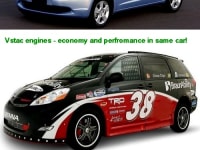
Imagine for a moment, a reasonably priced automobile with 5 or even 11 different sized engines in it, one for every driving situation from creeping along in traffic to safely towing a large boat or travel trailer up a mountain.
A powerful computer system controls which engine to use in every situation and thus gives the best possible fuel economy and concomitant lower emissions no matter what the driving conditions are at the moment. You have a durable green economy car and a muscle car in the same vehicle without the need to give up comfort, space and safety. This is an unprecedented capability not currently available anywhere in the world marketplaces at any price.
US Patent #7,779,627 is for an amazingly simple yet highly innovative computer controlled internal combustion engine that accomplishes this dream. It literally smoothly changes its size dynamically in response to real driving needs. The engine meets and exceeds global fuel consumption and emission standards for its entire range of operation without the need for expensive and heavy battery packs or charging stations. http://www.youtube.com/watch?v=ycxA3oF_2Ws is an animation of a sample engine configuration in operation.
This is accomplished automatically in a cost effective manner with an amazingly simple mechanism that can be manufactured in existing facilities without a huge investment in infrastructure or new technological breakthroughs. It can be brought to market in a relatively short time.
The marketplace for such innovation encompasses all uses of internal combustion engines from fractional horsepower engines to container ship engines of over 100,000 horsepower and everything in between. It is global and arguably the largest industrial complex in the world.
The invention does not require any new gears, linkages, levers, bearings, seals or other mechanical components and can utilize over 120 years of improvements already in place. It is multi-fuel.
The invention works by dividing the conventional piston/cylinder configuration of an internal combustion engine into independently controlled parts such that it is possible to disable all or part of a combustion chamber when less than full power is needed or desirable. It does this without changing the center of gravity of the rotating mass of the engine so vibrations are kept to a minimum. Any cylinder portion not in use is not using any fuel or creating any unfavorable emissions. The computer always delivers the minimum amount of power needed to meet current needs and no more.
The business plan calls for the licensing of the technology to existing engine manufacturers that are already established in global markets rather than attempting to manufacture engines ourselves.
A recent National Science Foundation review of the invention made the following statements:
“This is essentially unique” and “This could be a game changer in one of the largest segments of the global economy.”
“Exceedingly high intellectual merit.” “Worthy of being funded for its potential game-changing impact in a huge part of the economy.”
“The outcome (of development) could affect the transportation industry in positive ways, with corresponding reduction of emissions with its concomitant benefits.”
Video
-
Awards
-
 2012 Top 100 Entries
2012 Top 100 Entries
Like this entry?
-
About the Entrant
- Name:James Ries
- Type of entry:individual
- Software used for this entry:Sketchup for 3D Drawings
- Patent status:patented








